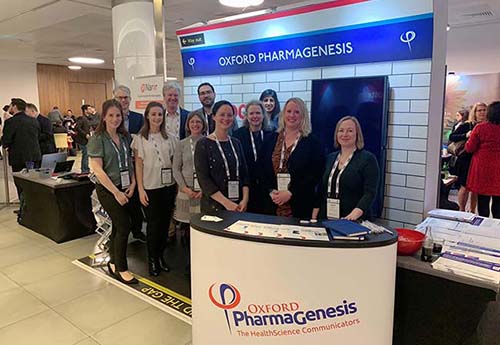In January 2020 over 350 medical publication professionals from across industry, publishers and agencies came together in London to attend the European meeting of ISMPP; we were there as a 10-strong team to experience first hand the engaging programme on offer. We were also lucky enough to have six posters accepted, including two oral poster presentations; several of these posters were the outcome of collaborations with our clients in Takeda, Novartis and Ipsen.
Our profession is making steady progress on key issues of openness and transparency
Day 1 kicked off with a review of 2019, identifying the public’s rising lack of trust in scientists, the effect of the ‘publish or perish’ attitude in science, and the developments in best practices as key themes. It was great to see notable steps forward highlighted regarding open access, data sharing, data protection and the efforts to identify and avoid predatory journals.
Then it was time to knuckle down into discussions of how we, as medical publication professionals, can improve our reach with our publication audiences. Topics ranged from discussing developments in publication enhancements and digital technologies, to how we should stop using PowerPoint badly and instead harness it more effectively to drive engaging storytelling.
Data really is beautiful
The keynote presentation on Day 1, ‘Data is Beautiful’, from the renowned author and data journalist David McCandless, was a spellbinding demonstration of how visualization techniques can help us to comprehend the seemingly incomprehensible and allow us to find unsuspected patterns in the data.
The afternoon roundtable sessions catered to a wide range of interests and specialist topics, from the practical challenges of authorship to preprints and metrics; the small group setting provided a great opportunity to share insights and viewpoints.
Publications professionals need to forge new partnerships
The novel publication partnerships session posed some questions for consideration. It’s clear from the upward trend in new journals that publications are not going away any time soon, but we can do much more in terms of sharing knowledge; a clear, single message delivered via a multichannel approach may better reach time-poor audiences, particularly as physical attendance at congresses comes under increasing pressure.
There was no let-up in the pace of proceedings on Day 2. To start, attendees were asked to choose to attend two out of three fantastic sessions: how to build on publications to develop wider communication strategies; a guide to plain language summaries; and the role of the scientific communication platform in driving clear and consistent communication.
We can enhance value across the data journey
The next session addressed how we can enhance value across the data journey, raising interesting discussions around taking a complementary rather than combative view of real-world evidence and randomized clinical trial approaches, the need to simplify messages and to deliver evidence with passion. The importance of open access was again emphasized: without access, audiences will go elsewhere for information, which may not be as rigorously validated.
Selected member research presentations reflected the key themes of the meeting around open access and digital technologies, including a novel ‘value-based’ metric framework to measure the impact of scientific publications, an assessment of preprint services such as bioRXiv and the rates of conversion to full publication, and the use of an AI-based Manuscript Assessment Tool (MAT) to aid quality checks and reduce time to journal submission.
The future is wide open
Amelia Kallman’s keynote presentation on Day 2 took us on a journey exploring some of the potential future developments in the digital space, providing exciting glimpses of what might be possible, set against caution surrounding the risks of an increasingly digital approach. This provided a smooth segue into the final session of the meeting, which provided a great snapshot of technologies being implemented right now, both in clinical trials and general clinical practice. Overall the 2-day meeting provided everyone with some fantastic food for thought and a great opportunity to refresh our approach by hearing new ideas.

